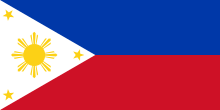ទង់ជាតិហ្វីលីពីន
ទង់ជាតិនៃប្រទេសហ្វីលីពីន ( ហ្វីលីពីន: Pambansang watawat ng Pilipinas ) គឺជាទង់ជាតិទ្វេពណ៌ផ្តេកដែលមានខ្សែស្មើៗគ្នានៃពណ៌ខៀវរាជ និង ក្រហមក្រម៉ៅ ជាមួយនឹងពណ៌ស ត្រីកោណសមមូលនៅលើក ។ នៅចំកណ្តាលនៃត្រីកោណគឺជាព្រះអាទិត្យពណ៌លឿងមាសដែលមានកាំរស្មីបឋមចំនួនប្រាំបីដែលនីមួយៗតំណាងឱ្យខេត្ត មួយ។ [lower-alpha ១] នៅចំនុចកំពូលនីមួយៗនៃត្រីកោណគឺជាផ្កាយប្រាំជ្រុង ពណ៌មាស-លឿង ដែលនីមួយៗតំណាងឱ្យក្រុមកោះសំខាន់មួយក្នុងចំណោមក្រុមកោះសំខាន់ៗចំនួនបីរបស់ប្រទេស - លូសុន, វីសាយ៉ាស (ទោះបីជាដើមឡើយសំដៅទៅលើកោះផានី ) [lower-alpha ២] និង មីនដាណាវ ។ ត្រីកោណពណ៌ស តំណាងឱ្យ សេរីភាព សមភាព និង ភាតរភាព ។

លក្ខណៈពិសេសប្លែកនៃទង់ជាតិនេះគឺការប្រើប្រាស់របស់វាដើម្បីបង្ហាញពីស្ថានភាពនៃសង្រ្គាម ប្រសិនបើវាត្រូវបានបង្ហាញដោយផ្នែកពណ៌ក្រហមនៅលើកំពូល ដែលត្រូវបានសម្រេចបានយ៉ាងមានប្រសិទ្ធភាពដោយការបង្វិលទង់ជាតិចុះក្រោម។ [១៧]
ឯកសារយោង
កែប្រែ- ↑ ១,០ ១,១ Lone, Stewart (2007). Daily Lives of Civilians in Wartime Asia: From the Taiping Rebellion to the Vietnam War. Greenwood Publishing Group. p. 50. ល.ស.ប.អ. 978-0-313-33684-3. https://books.google.com/books?id=qmSnTIAPnoUC.
- ↑ Al, Antonio, Et. Side by Side 5' (2002 រ.រ.). Rex Bookstore, Inc.. p. 26. ល.ស.ប.អ. 978-971-23-3300-2. https://books.google.com/books?id=qoNNkzGNqYgC.
- ↑ ៣,០ ៣,១ Ocampo, Ambeth R. (1993). Aguinaldo's breakfast & more Looking back essays. Anvil Publishing. p. 65. ល.ស.ប.អ. 978-971-27-0281-5. https://books.google.com/books?id=1WlwAAAAMAAJ.
- ↑ Benjamin R. Beede (1994). The War of 1898, and U.S. Interventions, 1898–1934: An Encyclopedia. Taylor & Francis. p. 418. ល.ស.ប.អ. 978-0-8240-5624-7. https://books.google.com/books?id=48g116X9IIwC.
- ↑ ៥,០ ៥,១ Al, Carpio, Et. My Country and My People 5. Rex Bookstore, Inc.. p. 139. ល.ស.ប.អ. 978-971-23-2254-9. https://books.google.com/books?id=7UUuHLJYdlMC.
- ↑ President Emilio Aguinaldo, Acta de la Proclamacion de la Independencia del Pueblo Filipino, Kawit, Cavite: June 12, 1898, "...triángulo blanco como distintivo de la célebre Sociedad "Katipunan" que por medio de pacto de sangre empujó a las masas a insurreccionarse; representando las tres estrellas las tres principales Islas de este Archipiélago, Luzon, Mindanao y Panay en que estalló este movimento insurreccional; indicando el sol los agigantados pasos que han dado los hijos de este país en el camino del progreso y civilización, simbolizando los ocho rayos de aquél las ocho provincias: Manila, Cavite, Bulacan, Pampanga, Nueva Ecija, Tarlac, Laguna y Batangas, declarando en estado de guerra apenas se inició la primera insurrección; conmemorando los colores azul, rojo y blanco los de la bandera de los Estados Unidos de la América del Norte, como manifestación de nuestro profundo agradecimiento hacia esta Gran Nación por la desinteresada protección que nos presta y seguirá prestando.", quoted from "Design of the Philippine Flag". Symbolisms/Meanings in the Philippine Flag. National Commission for Culture and the Arts of the Philippines. May 18, 2015. Archived from the original on February 7, 2017. Retrieved មីនា 4, 2023.
{{cite web}}: More than one of|archivedate=and|archive-date=specified (help); More than one of|archiveurl=and|archive-url=specified (help) - ↑ "FULL TEXT: Pres. Benigno Aquino III's Independence Day speech". Sun.Star. June 12, 2015. Archived from the original on August 15, 2015. Retrieved September 23, 2015.
{{cite web}}: More than one of|archivedate=and|archive-date=specified (help); More than one of|archiveurl=and|archive-url=specified (help) - ↑ Cite error: Invalid
<ref>tag; no text was provided for refs nameddeclaration - ↑ Cite error: Invalid
<ref>tag; no text was provided for refs namedmalacanang - ↑ ១០,០ ១០,១ A. P. Samest Blaustein; Jay Adrian Sigler; Benjamin R. Beede (1977). Independence documents of the world. 2. Brill Archive. p. 570. ល.ស.ប.អ. 0-379-00795-9. https://books.google.com/books?id=3FzT7IFsSKoC.
- ↑ Zaide, Sonia M. (1999). The Philippines: A Unique Nation. All-Nations Pub.. p. 259. ល.ស.ប.អ. 978-971-642-071-5. https://books.google.com/books?id=6YMsNgAACAAJ.
- ↑ Zaide, Sonia M. (1994). The Philippines: A Unique Nation. All-Nations Publishing Co.. p. 259. ល.ស.ប.អ. 971-642-071-4.
- ↑ G. Nye Steiger, H. Otley Beyer, Conrado Benitez, A History of the Orient, Oxford: 1929, Ginn and Company, pp. 122–123.
- ↑ "... and because I know them better, I shall start with the island of Cebu and those adjacent to it, the Pintados. Thus I may speak more at length on matters pertaining to this island of Luzon and its neighboring islands..." BLAIR, Emma Helen & ROBERTSON, James Alexander, eds. (1903). The Philippine Islands, 1493–1803, Volume 05 of 55 (1582–1583), p. 35.
- ↑ "Origin of the Symbols of our National Flag | Presidential Museum and Library". Archived from the original on មិថុនា 10, 2013. Retrieved September 15, 2021.
- ↑ "Iloilo remembers first PH flag-raising outside Luzon". Philippine News Agency. November 16, 2019. Retrieved February 18, 2021.
- ↑ Jerry E. Esplanada (September 27, 2010). "RP flag blooper in New York not intentional—US embassy". Philippine Daily Inquirer. http://globalnation.inquirer.net/news/breakingnews/view/20100927-294642/RP-flag-blooper-in-New-York-not-intentionalUS-embassy.
Cite error: <ref> tags exist for a group named "lower-alpha", but no corresponding <references group="lower-alpha"/> tag was found